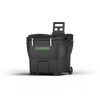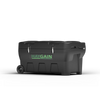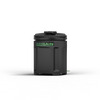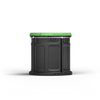Why do horses suffer from filled legs?
Filled legs or lower leg swelling is not uncommon in stabled horses throughout the year. Dr David Marlin tells us what it is and why it happens.

Dr David Marlin
Scientist, 10/08/2020

Swelling in the lower legs of horses is not that uncommon. The medical term for this swelling due to accumulation of fluid is oedema. The fluid is not blood or even plasma but referred to as interstitial fluid and this is the fluid that surrounds the cells in the body. When oedema/swelling occurs, this is due to an accumulation of interstitial fluid in the tissues. It is perfectly normal for there to be fluid between the cells. In fact around 15% of a horses total fluid is interstitial fluid. Swelling in the lower legs due to oedema can also lead to sore limbs and stiff joints. So where does it come from and where does it go and why does it sometimes accumulate and lead to swelling?
The arterial blood that is pumped around the body is at high pressure. As the blood flows under high pressure through the smaller arterial blood vessels and even smaller capillaries that supply all the tissues (e.g. the skin) and organs (e.g. lung, liver, brain, etc) with oxygen and nutrients, some of the fluid is literally squeezed out of the vessels into the spaces between the cells. The red blood cells and many of the proteins in the blood are too large to pass through the walls of the smallest blood vessels and capillaries, so interstitial (in Latin “between place”) fluid is a filtered version of the blood. It is salty and almost clear. Normally, the fluid that is squeezed from the blood into the spaces between the cells in all the tissues and organs is slowly cleared by the lymphatic system, which is part of the vascular system (circulatory system). When interstitial fluid enters the lymphatic system it becomes known as lymph, derived from the Latin word for water, lympha).
The lymphatic vessels run separately within the body but close to the blood vessels and eventually return the lymph back into the blood via the veins. The lymph flows back along the lymphatic vessels either due to contractions of the vessels (a bit like the contractions of the intestinal walls move food along) or by external compression due to muscular contractions.

Swelling or filling of the lower legs occur either when the amount of lymph produces is greater than normal or the clearance of lymph is slower than normal and sometimes due to a combination of increased production and slow clearance.
There are many different reasons why filled legs can develop. These can include kidney disease, heart failure, chronic lung disease, thyroid disease, liver disease, damaged blood vessels, damaged nerves, damage to or blockage of the lymphatic vessels, malnutrition, parasites, medications that cause high blood pressure, blood clots, injuries, burns, bites, allergic reactions, reduced activity and hot weather.
Probably the most common time for owners to notice horses with filled legs is when they spend a long time in their stable, either on box rest or overnight. This type of oedema usually affects all legs and resolves when the horse is exercised or turned out. The degree of swelling can often be reduced by appropriate bandaging and massaging the lower limbs may help promote flow of lymph. If there is pain associated with the swelling then col-hosing or ice boots may provide some relief. In some cases cold hosing or application of ice-boots in the evening may also help reduce the amount of oedema.
It’s easy to understand why this occurs so often in horses. Firstly, lymph flow back into the circulation is encouraged by activity and muscular contraction. Horses in the wild cover long distances at walk each day whilst stabled horses have long periods of inactivity. In addition, in people muscle contraction around the lymph vessels is important for the return of lymph, but horses have no muscle below the knee.
Other causes of oedema which can be more serious include infection in the skin, known as cellulitis. This is likely to only affect a single limb. The same is likely to apply to insect bites. Allergic reactions may result in single or all legs being affected.
How can ComfortStall help horses with filled legs?
ComfortStall's orthopedic padded flooring absorbs shock and provides cushioned anti fatigue support to joints, tendons and ligaments thereby helping to prevent and manage musculoskeletal health issues including filled legs.





















